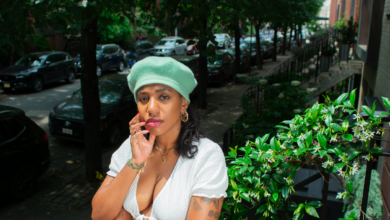

The great dancer, choreographer, and founder of the Brooklyn-based Evidence dance company Ronald K. Brown has a familiar story that echoes generations of artists dating back to Alvin Ailey’s professional debut as a performer on the Brooklyn Academy of Music stage in 1957. His relationship to dance, his way into the artform that would define his life, begins with Ailey himself. “The story is that when I was in the second grade, I went on a school trip to see the American Dance Theater, and then I went home and I started making dances,” the Bed-Stuy product tells me on a Wednesday afternoon in late May. We are on the phone, but I am in a conference room in the Alvin Ailey American Dance Theater on the far west side of midtown Manhattan. Brown skips ahead to the next crucial juncture in his Ailey lore, driving home the seismic, incalculable impact Ailey has had on the American modern dance landscape. “I was 21 years old and I was rehearsing at the Ailey school, and Mr. Ailey came and sat next to me and he asked, ‘Are you one of mine?’” And I said, ‘Mr. Ailey, I did not go to this school, but yes, I’m one of yours.’”
I’m practically in the Hudson River—at West 55th Street and 9th Avenue—at the latest iteration of the Ailey Company School, because I’m about to watch rehearsals for The Holy Blues, the new performance piece from Fulbright Scholar Jawole Willa Jo Zollar—which will be her first “major work” after stepping down from the landmark company she founded, Urban Bush Women—premiering as part of the Alvin Ailey American Dance Theater’s performance at BAM, running from June 5 to June 8. After a break of over a decade throughout the 2010s, the Ailey Company is back for the third consecutive Summer at the Brooklyn institution that can be thought of as Alvin Ailey’s ancestral home. “Mr. Ailey was part of [BAM’s] early days in the 60s, and part of why we wanted to bring the company back was to honor that history, to celebrate it, and to make it easier for Brooklyn to see it,” BAM Artistic Director (and former general manager of Urban Bush Women) Amy Cassello tells me. “With Ailey Company, it’s a sense of homecoming that is not always present. There’s an ownership, like a favorite ‘prodigal son makes good’ kind of thing. A lot of dancers live in the borough, and it’s like being able to play to a hometown crowd.”

Performance of Grace (Photo by Danica Paulos for The Alvin Ailey Company)
This year’s performance is rich with meaning and steeped in history, a celebration of the troupe— in the midst of a moment following the adored, brilliant “Edges of Ailey” exhibit at the Whitney earlier this year—and of BAM, and the cross-pollination between these two institutions that have been in conversation with one another over the course of seven decades. The program features Ron Brown’s beloved Ailey co-production Grace, and Elisa Monte’s Treading, a 1979 piece that “premiered at BAM and was really quite a sensation when it was here,” Cassello says. But the headliner is The Holy Blues, a world premiere and Zollar’s inaugural act as the 2025/26 Ailey Company artist-in-residence.
As someone with little to no vocabulary for dance, who attends the occasional show at Lincoln Center but interacts with it on the level of an infant ogling their nursery mobile, I didn’t know what to expect as I stepped into the high ceilinged and pristinely white rehearsal space that takes up a large chunk of the sixth floor of the Ailey Company school building. Out of the two floor-to-ceiling windows that make up two walls of the space, it’s a gray, drizzling mid-afternoon, surrounded by the rooftop water towers and midsections of taller luxury apartment buildings of Midtown West.
The dancers are scattered around the space, each claiming their own sections on the edges of the room allowing for halos of movement, splayed out on the sprung floor in very soft and comfortable looking sweatpants and yoga pants and tights and mesh shorts and tanks and t-shirts that have been cropped and hand-tailored with scissors at the neckline and at the sleeves and at the waist. As they take water and stretch, they are Amy Sherald portraits—beautiful and sculptural, athletes at their physical peaks, rotating their arms or bending their legs and listening to what their muscles and joints are telling them—artists who are attuned to their bodies and understand their bodies in ways the rest of us never will.
Jawole Willa Jo Zollar jumps up to greet me, wearing a breathable navy sweatsuit and sheer socks. Her twin buns are flecked with gray, but she is on the balls of her feet and possessed with a childlike energy and enthusiasm for the moment. “What I want to emulate is that I’m creating, I’m finding new territory, and I’m not like thinking, ‘Oh, well, now I’m old, so I better just do this thing I know.’ I want to play what I don’t know. That’s what I want to explore,” she’d tell me later.

Performance of Revelations (Photo by Danica Paulos for The Alvin Ailey Company)
It’s the second day of rehearsal for the show. I had expected that to mean the company would be meticulously rehearsing specific phrases and exact blocking, practicing a piece that had been mapped out by the inch and millisecond over months if not years of micro-managed plotting, but it’s something else entirely. I am walked over to a corner where two adjacent walls are littered with index cards, grouped into columns headed by categories: “Phrases,” “Sections,” “Themes,” “Music Concepts,” and “Discoveries/Explorations/Experiments,” broad signposts for the structure of the performance, juxtaposed and played with several times during my hour of observation. The piece, two weeks from premiere, is being discovered in front of me, in real time, in a fluid and highly collaborative process with Jawole and her collaborators, Samantha Figgins and Chalvar Monteiro, and her choreographic collaborator of 21 years, Vincent E. Thomas. “The piece is not locked, we’re creating it…we ask [our dancers] to stay in their body as they need to be, to be game and open to the process,” Jawole says.
The company begins rehearsing a modern dance interpretation of a ring shout in the parlance of Ailey and Jawole, scored to Sam Cooke and the Soul Stirrers’ “One More River to Cross.” The ring shout is an African cultural practice that was adopted by revivalist Christianity in the antebellum South. In the company’s hands it is an elegant and kinetic, clapping, swirling, circling formation of eight bodies, with one member of the group occasionally moving into the center and employing phrases that look like freestyling but are actually quite carefully choreographed, modeled after “different states of prayer, falling prayer.” I ask Jawole if this will be the opening of The Holy Blues, she raises an eyebrow, smiles and responds with genuine, playful uncertainty, “Maybe!” then laughs. “It’s about creating story in the body, finding story, both collectively and individually in the body, and also creating works that bring story to the stage. That was what Mr. Ailey did,” she tells me.
The Holy Blues is a piece tying African rituals and traditions to their American translations in both gospel and the blues, the spiritual and the secular, derived from an Alvin Ailey diary entry that reads “My roots are also in the Gospel church, the Gospel churches of the south where I grew up…holy blues—paeans to joy, anthems to the human spirit.” It is a piece unwittingly in dialogue with this moment in pop culture, dominated by Ryan Coogler’s blockbuster sensation Sinners, about the white vampirism of Black culture in an early 20th-century Clarksdale, Mississippi, dominated by the blues. “There is something in the air. It’s coming up in a lot of different ways,” Jawole tells me when I ask her about the film she greatly admired. “There’s a southern resurgence of the blues. Gospel and the blues-how our ancestors connected to this history, specifically in that scene,“ she says, referring to Coogler’s masterful oner that places the entirety of American Black art in a single seamless shot. “I was like, okay, my mind is blown … .within a lot of African cosmology, the past, present, and future exist together.”
That was front of mind as I watched the company explore another section of The Holy Blues, in which the dancers were instructed to react to The McIntosh County Shouters’ spiritual “Oh Lord, I Want You To Help Me.” They are scattered across the space, and play a game of high-leverage freeze tag, like the most accomplished imaginable visions of those automated children’s toys that gyrate to sound cues. The company must react to snippets of sung blues vocals, undulating to the singing, and then stopping in tortured positions when the voice dies out, waiting for the next lyric. What is astonishing is their movement, somehow just on their second day of rehearsing, appears so practiced and polished it seems impossible they’re finding these perfect responses through improvisation in the moment. “They are amazing, they are elite, they’re all in,” Jawole says, marveling at the highly trained, globally talented dancing clay she has to work with.

Performance of Revelations (Photo by Paul Kolnik for The Alvin Ailey Company)
It’s fascinating watching the dancers interpret sound through motion, watching Jawole and company coach and direct them through what she described as “physical transcriptions”, trying to articulate how a voice sounds and how to interpret it with motion. “Focus on the syncopation in the phrasing that gets us out of 5/6/7/8,” she instructs her company at one point, using the blues and its rhythms to jolt the performers out of metronomic, hardwired, European timing. It is an articulation of Alvin Ailey’s lifework. “He brought these stories of African Americans to life, and then as he progressed, even when his work was abstract, they were still full of story. And that’s something I’m interested in, that’s how I work. I work the story.”
Appropriately, The Holy Blues is a piece that immediately insists upon its place in Ailey’s canon alongside his classic Revelations, a body of work that, to quote Gia Kourlas’ review of Ron Brown’s Grace on the occasion of its 25th anniversary in the Times, encapsulates the Ailey project, “Weaves together modern and contemporary dance with West African forms,” particularly African American spiritual traditions, which is why BAM is the perfect place to debut it. “I’ve seen Ailey here and I’ve seen Ailey in Manhattan, and I just think, honestly, Brooklyn crowds are better. They are vocal, they’re excited. It’s intergenerational, the people who’ve seen Ailey many times, people here for the first time, people who’ve heard about Revelations but have never seen it live. I’m obviously biased, but I do think that there’s something special about performing in the opera house and knowing that Mr. Ailey walked these corridors.”
I also asked Jawole how Alvin Ailey had informed her work, and she responded in the same awed vein as Ron Brown. “I don’t even know if I can answer that because my work couldn’t exist without Mr. Ailey. He opened the way to see, to understand how to marry the personal and collective Black experiences through dance.”
The post The Alvin Ailey Company Comes Home Again appeared first on BKMAG.
Source link







